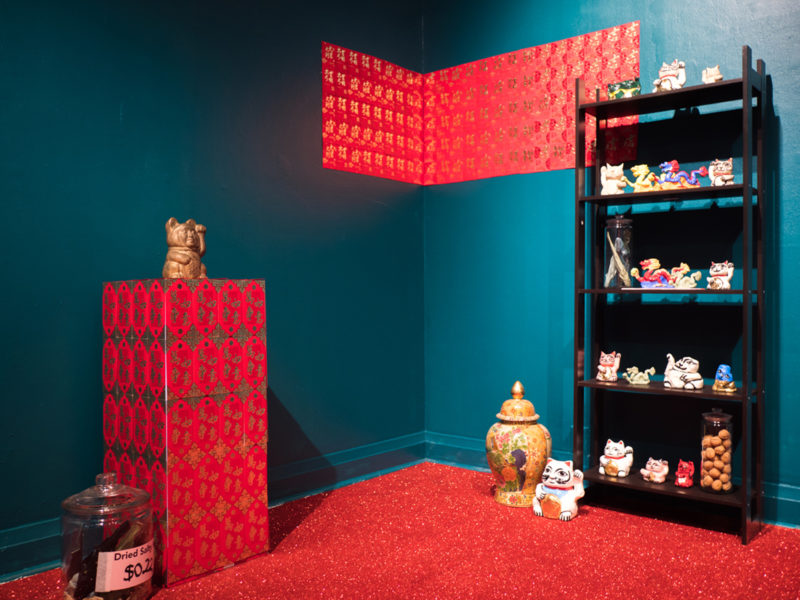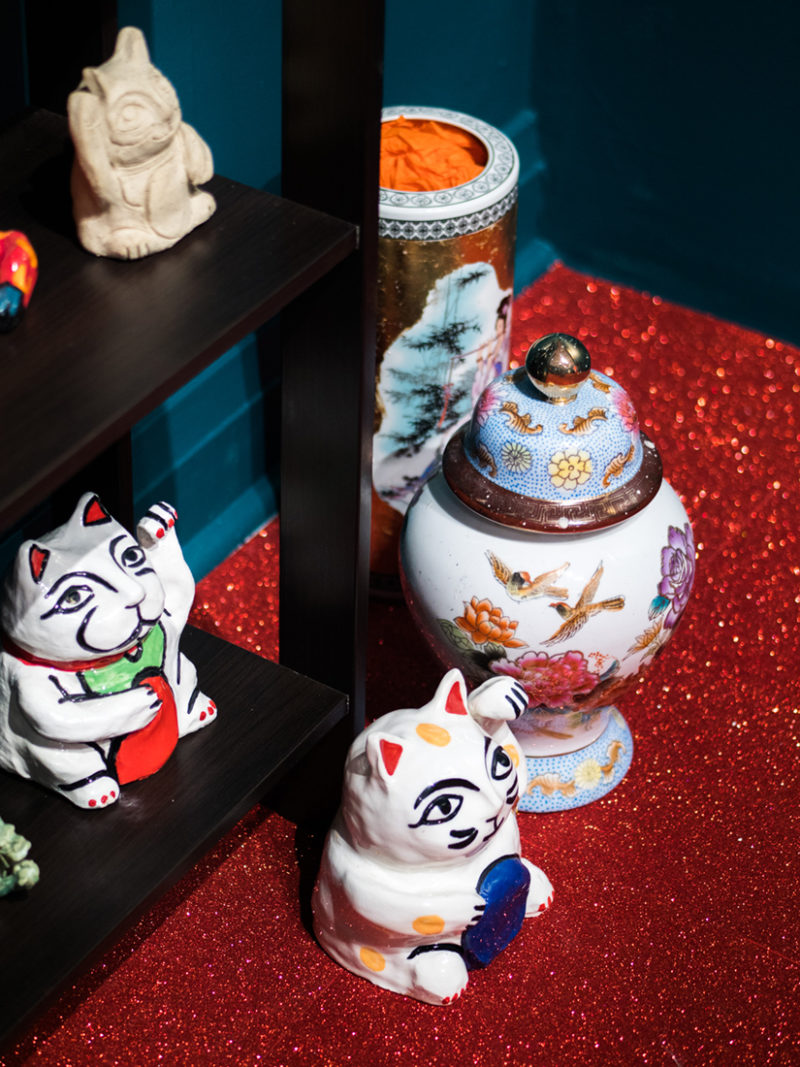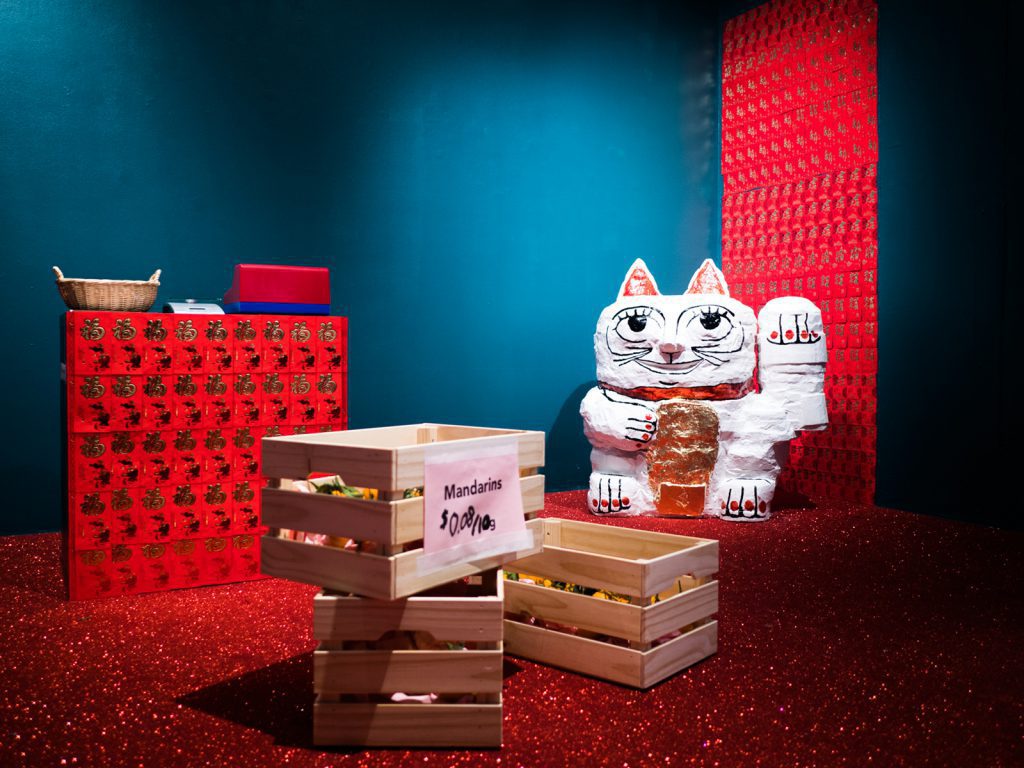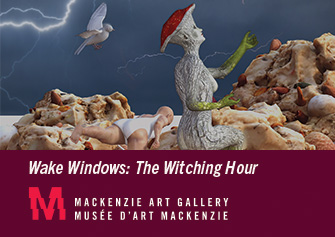Fortune Flavors the Bold at Xpace’s Project Space
11 September 2019
By Rebecca Casalino
Before entering Arezu Salamzadeh’s Fortune Flavors the Bold you must take off your shoes. Sock-footed, you are greeted by glittering red foam installed over the floor of Xpace Cultural Centre’s Project Space. Dark teal walls enclose the gallery, framing crates and shelves of items for sale. Fresh mandarin oranges are available to purchase as snacks, there’s also ginger and colourful ceramic casts of salty fish inside large glass jars. Salamzadeh stands by the cash register (a children’s toy brightly coloured with large cartoonish buttons) tattooed with lucky cats, selling art and chatting with visitors. She wears gold which compliments the New Years pouches decorating the walls and plinths in large blocks of red. Behind her, a gold sign with small red lights reading FORTUNE hangs above a gumball machine. On the other side, a large lucky cat about the same size as the viewer squats beside, as if to snap a picture.

Salamzadeh is first-generation Canadian, living in Mississauga and working out of her home studio. During the opening, Salamzadeh’s mother, who grew up in Hong Kong, could be seen weaving through the crowd of sock-footed millennial’s smiling at her daughter. Seeing a parent at an art opening brings so much joy to me as a viewer, her supportive presence buttressing Salamzadeh’s exploration of her Hong Kong heritage. Abby Ho writes in her accompanying essay that Fortune Flavors the Bold presents “multitudes of objects that bring good fortune”. (1) Ho de-codes symbols specific to Chinese culture, like dragons and red packets, allowing viewers to easily approach Salamzadeh’s installation. In exploring the objects that surrounded her as a child, her work creates a feeling of nostalgia which is contrasted by the new and trendy colour palette glazing her sculptures. Salamzadeh’s choice to allow her roots to bleed into her practice creates a more politically relevant and socially engaged installation.
The shelves, crates, baskets, and jars of goods create a retail shop-like atmosphere in the gallery. Salamzadeh re-imagines the space as a marketplace, where weighing her art in front of the customers critiques institutional standards of value—she seems to propose a more socially engaged conversation surrounding art and capitalism. Her choice to sell smaller, more affordable sculptures speaks to the financial anxiety humming through the city. The expense of living in Toronto is stifling, and walking into galleries with expensive sculptures and paintings can feel overwhelming in an economy that does not support the surrounding community. In this sense, Salamzadeh pricing her work by weight is a breath of fresh air. Shows about painting or virtual reality seem far removed from my world, so out of reach both socially and economically. The walls get whiter and whiter as my budget gets tighter and tighter. It often seems like we are encouraged to hide the labour involved in maintaining a practice, as well as the financial burden that comes with being an emerging artist. Salamzadeh’s practice pushes against this notion, and instead exists in spaces where I feel most comfortable: zine fairs, multiples shows, or artist-run spaces that focus on emerging and marginalized voices. Fortune Flavors the Bold was an opportunity for Salamzadeh to directly engage with her audience and create a shared experience for the community. Rather than posing as obvious objects of luxury, her small sculptures have a kind of sympathetic essence relatable to almost any viewer.

Salamzadeh also harnesses campy aesthetics through her use of cultural Chinese knick-knacks, a selection which juxtaposes the traditional and more contemporary quirky motifs. Heirloom objects inevitably become re-contextualized as generations pass it along, and the original context becomes further and further removed. Salamzadeh channels this shared—yet disjointed—intergenerational experience by brightening the classic colour palette to resonate more effectively with contemporary pop-y aesthetics. The seafoam green, baby blue, and bubble-gum pink dragons play on the shelf beside their stoic and majestic jade counterparts. This playful approach to the generational gap in style between immigrant parents and their children is a fun poke at what we consider to be contemporary or fashionable.
The sparkling floors, campy colour palette, and exaggerated elements of play feel to me influenced by the new drag scene that has emerged from RuPaul’s Drag Race. Salamzadeh is a queer artist, but her use of glamour and luxurious textures is a formal choice rather than a direct reference to drag. My interpretation is tinted with the media content I consume, and therefore also expresses how I see queer culture bleeding into popular culture as drag enters the mainstream consciousness, such as the mimicking of mass-produced objects created individually in her home ceramics studio. The hand painting and glazing of each sculpture is what differentiates them from their cast originals; their wobbly borders of colour value the artist’s gesture over the uniformity of mass production. The gesture becomes cheekier as the process is repeated; the gallery is lined with sculptures of waving cats and ornate dragons resembling commercialized knick-knacks, but with the artist’s own twist. By embracing more pulpy and humorous themes in her art, Salamzadeh snubs her nose at formal rules set by institutions and plays messily in the gallery space, inviting the audience to join her in a conversation around how art can alternatively exist in our lives.
With the exhibition’s title, Salamzadeh flexes her wit by commandeering a Latin proverb for her own purposes; to make the audience giggle. In a new political age where marginalized voices are more valued by the majority, we are hearing a whole new set of stories in the mainstream. Salamzadeh, with her mixture of performance, sculpture and installation, is one of the emerging voices I am excited to hear more from. The only question remaining is: How she will top the stunt of tiling the gallery floor with a stubbornly sticky material like glitter?
1. Exhibition essay, Arezu Salamzadeh: Fortune Flavors the Bold by Abbey Ho. (http://www.xpace.info/wp-content/uploads/2018/10/Project-Space_Arezu-Salamzadeh_Essay.pdf)
Fortune Flavors the Bold ran from January 18 – February 16, 2019 at Xpace Cultural Centre’s Project Space Gallery in Toronto, ON.
Feature Image: Installation view of Fortune Flavors the Bold by Arezu Salamzadeh. Photo by Polina Teif courtesy of Xpace Cultural Centre.



